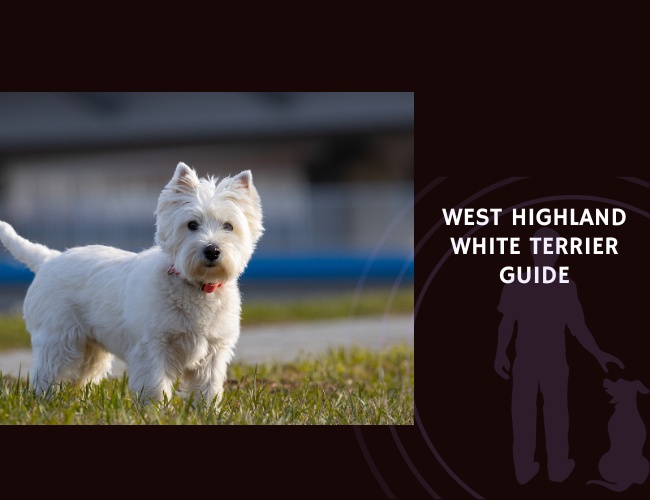Introduction to the West Highland White Terrier
A Brief Look at the Breed’s Roots
The West Highland White Terrier, often called the Westie, comes from Scotland. This breed was originally developed to hunt rodents, using its sharp senses and determination to control pests in the rugged Scottish landscape. Over the years, the Westie’s distinct white coat set it apart from other terrier types, making it easier to spot during hunts.
Distinctive Physical Traits
Westies are known for their crisp, white double coat. This coat isn’t just for good looks—it protects them from Scotland’s wet and chilly climate. Small but sturdy, these dogs usually weigh around 7kg to 10kg and stand about 25cm to 28cm tall. Their pointed ears, dark round eyes, and constantly wagging tail give them an alert and cheerful appearance. The signature white color is more than a fashion statement; it traces back to the breed’s original purpose, where white dogs were less likely to be mistaken for other animals during hunts.
Popularity and Breed Recognition
Westies have captured the hearts of many across the world. Their charm reached far beyond Scotland, quickly gaining fans in the United States and elsewhere. They are now a familiar sight in dog shows and are recognized by major kennel clubs. Their friendly personality and manageable size fit well with many lifestyles, from city apartments to family homes.
The Westie’s popularity is not just about looks—people cherish them for their lively spirit and adaptability. This makes them a favorite among both experienced dog enthusiasts and first-time pet owners.
Next, we’ll explore what makes the Westie’s personality so special and how these traits play out in daily life.
Character & Temperament
Personality traits and temperament
West Highland White Terriers, often called Westies, are well-loved for their cheerful and confident attitudes. These small dogs have a spirited nature that shines through in their everyday actions. Most Westies display a bold personality and enjoy being the center of attention. They are affectionate with their families and tend to form strong bonds with their owners. Many owners notice their Westies are playful, lively, and full of curiosity.
Despite their size, Westies are not timid. They approach life with courage, often acting bravely around dogs much larger than themselves. However, they balance their daring side with loyalty and a deep need for companionship, making them good family pets.
Prey drive: genetics and environment
A key trait in Westies is their noticeable prey drive. This trait comes from their origins as hunting dogs. While there is no specific scientific data just for Westies, general studies show that a dog’s instinct to chase is shaped by both genetics and early experiences. If raised in an environment where they are exposed to small animals, their hunting instincts may become more pronounced. Owners should always be aware of this and provide outlets, like toys and games, to manage their instincts in a safe way.
Social intelligence and independence
Westies show remarkable social intelligence. They read emotional cues from people and other pets, which helps them fit smoothly into many settings. Research suggests dogs like the Westie can make decisions based on observing others, showing both cleverness and independent thought. Their independence means they might not always follow instructions at once—they like to think for themselves. This makes for a pet that keeps life interesting, often surprising owners with clever solutions to daily puzzles.
With their blend of delightfully bold personalities and quick minds, Westies bring a spirit of fun into many homes. Moving forward, understanding how to guide and support their independent nature is key to a positive relationship.
Training & Education
Encouraging Cooperation: Training for a Westie’s Independent Mind
West Highland White Terriers (Westies) have a reputation for being clever, strong-willed, and quite independent. Because of their working terrier heritage, Westies usually love to think for themselves. This means they respond best to positive reinforcement. Using treats, toys, praise, and play keeps training sessions fun and helps these dogs stay engaged. Try to use short, varied lessons—Westies often become bored if tasks are too repetitive. For best results, reward your pup for even small progress and stay patient. Avoid heavy-handed corrections, as these confident little dogs may become more stubborn when pushed too hard.
Early Socialization: Building a Friendly, Adaptable Dog
Socialization during puppyhood sets the foundation for a well-adjusted adult Westie. Aim to gently expose your Westie to a variety of people, sounds, places, and other dogs between eight and sixteen weeks of age. The key here is gradual and positive exposure—bring your puppy to quiet parks, introduce them to friendly adult dogs, and invite new friends over for brief visits. Offering treats or play during new experiences helps your puppy associate new things with positive emotions. With patience and consistency, socialization will build confidence and help prevent shyness or overreactivity later in life.
Facing Common Challenges and Solutions
Behavioral challenges like barking, digging, or chasing are common in terriers. Understanding that these are instinctual behaviors—rooted in the breed’s history—helps in managing them. Channel your Westie’s natural curiosity and energy into structured games or puzzle toys. If unwanted barking or digging occurs, redirect your pup to an approved activity instead of scolding. Consistency, boundaries, and gentle insistence on rules set by the family are necessary for long-term success.
Training and socialization shape your Westie’s ability to thrive in a variety of situations, supporting a rewarding partnership between you and your energetic companion.

Nutritional Needs & Recommendations
General dietary requirements for small terriers
West Highland White Terriers Nutrition need a balanced diet tailored for small breeds. Their food should include high-quality protein, healthy fats, and digestible carbohydrates. Westies do best with dog food made for their size, as it helps support their faster metabolism and energetic nature. Consistent portion control is important since small breeds can gain weight quickly if overfed.
Energy needs and Westie metabolism
Westies are lively and active, often needing more calories per kilogram than larger dogs. An adult Westie usually needs about 40–50 calories per pound of body weight daily, but this can vary depending on their activity level. Helping your Westie stay at a healthy weight means making sure treats don’t make up more than 10% of their daily calorie allowance. Regular walks, play, and enrichment also play a role in calorie use and overall health.
Nutrition for every life stage
Puppies need food formulated for growth, with extra protein and nutrients for healthy development. Adults benefit from balanced, small-breed options with added omega-3 fatty acids, which may help protect their skin and coat. Seniors tend to need fewer calories, but require easily digestible protein and ingredients to help maintain muscle and joint health. Adjusting your Westie’s diet as they age can help support energy and well-being.
Remember, each dog is unique, so it’s wise to work with your veterinarian to fine-tune your Westie’s diet based on age, weight, and activity. A strong nutritional foundation helps keep your Westie feeling their best.
Understanding nutrition means you’re equipped to keep your Westie healthy, and you’ll be better prepared for other aspects of their care journey.
Health Concerns & Common Diseases
Skin and Allergy Issues
West Highland White Terriers often face skin troubles, with atopic dermatitis (AD) as a leading concern. This condition is common and has a genetic basis in the breed. Dogs with atopic dermatitis may itch, lick, or bite their skin, especially on their paws, belly, and ears. These behaviors can lead to red, inflamed skin and even hair loss. Because of the genetic link, it is likely that more than one Westie in a family line could be affected.
If your Westie shows signs of skin allergies, daily care is important. Regular bathing with gentle dog shampoos helps remove allergens from the coat. Keeping bedding and play areas clean also makes a difference. Veterinary visits are needed for proper diagnosis and to discuss treatments like allergy medications or special diets. Early management can help prevent serious flare-ups.
Other Noteworthy Health Conditions
While most available studies highlight skin issues, some concerns still stand out in Westies. Craniomandibular osteopathy (CMO) is a rare bone condition mostly affecting young puppies. This can cause pain while chewing and jaw swelling. Pulmonary fibrosis, a lung disease, is also occasionally seen in older Westies, causing breathing problems and a dry cough. Although research is limited, owners should watch for symptoms and consult a vet if they appear.
Preventative Care
Regular checkups with your veterinarian can catch health problems early. Routine screenings, such as skin exams and, if needed, x-rays or lung checks, will help your Westie live a healthier life. Keeping up to date with vaccinations, flea and tick prevention, and maintaining a clean home environment are all part of good preventive care. Early intervention always gives the best chance for a happy, comfortable companion.
Understanding common Westie health problems will help you stay prepared and proactive as your dog grows and thrives.
Orthopedic & Neurological Considerations
Joint Health and Common Orthopedic Issues
Westies, like many small breeds, can be prone to joint problems as they age. One issue often seen in small dogs is luxating patella. This condition happens when the kneecap moves out of place, sometimes causing limping or discomfort. Although current research does not talk specifically about luxating patella in Westies, it is still important to watch for signs like skipping, hopping, or favoring one leg. Early detection by your veterinarian helps prevent further damage, and managing your dog’s weight can lower stress on their joints.
Other orthopedic issues may include general wear and tear of the hips and elbows. As your Westie grows older, you might notice stiffness or slower movement, especially when getting up in the morning. Gentle daily walks, a comfortable bed, and keeping them at a healthy weight are helpful ways to manage these changes.
Neurological Health and Monitoring
Some small dog breeds can be at risk for neurological problems. One such condition is White Shaker Dog Syndrome, recognized for tremors or shaking, mainly in young to middle-aged dogs. While there is no direct research linking Westies to this syndrome, it is important for owners to monitor any unusual shaking, weakness, or trouble with coordination. If you notice any of these signs, speak with your veterinarian for guidance and treatment options.
Adapting to Age-Related Mobility Needs
As Westies age, mobility may decline naturally. You can support them by:
- Providing non-slip rugs or mats to prevent slipping
- Offering ramps or stairs for furniture access
- Keeping essentials like food and water easily accessible
Helping your Westie stay active, yet comfortable, ensures a happier and healthier life as they mature. 🐾
Moving forward, having a solid care routine will help you maintain a joyful and lively companion throughout the years.
Bold. Cheerful. Determined.
Westies light up a room.
With their perky ears, bright eyes, and confident strut, they carry themselves like they own the place. Don’t let the small size fool you—Westies have big personalities packed into compact bodies. Always ready for an adventure, they bring a spark of joy to daily life.
Independent yet affectionate.
Westies love their humans deeply, but they won’t cling. Their terrier roots give them a streak of independence that shows up in training and play. They’ll cuddle after a good walk—but only when they choose to. Earning their affection makes it even more meaningful.



Brave hearts with sharp minds.
There’s nothing hesitant about a Westie. They face the world head-on, even when it’s much bigger than they are. Behind their bravery is a clever brain—watchful, curious, and always thinking. Living with a Westie means staying on your toes and smiling a lot.
Lifestyle & Exercise Requirements
Daily exercise needs and appropriate activities
West Highland White Terriers are energetic dogs that love daily activity. Even though they are small, they are lively and alert. A typical adult Westie needs at least one walk each day—preferably 30-45 minutes. This can include brisk walks, play sessions, or games of fetch in a secure yard. Westies also enjoy exploring new scents and sights, so occasional changes in walking routes keep them interested. If you live in a busy area or have limited outdoor space, indoor play with toys and puzzle feeders is a great way to keep your Westie active.
Suitability for different living environments
Westies adapt well to a range of homes. They are just as happy in apartments as they are in houses with yards, as long as their exercise needs are met. In an apartment, it’s important to provide regular outdoor breaks for both exercise and mental stimulation. Access to a garden or yard gives extra space for your Westie to roam, but it’s not essential. Remember, their terrier instincts can lead them to dig, so be prepared if you have a garden!
Mental stimulation and enrichment
Westies are smart and curious. Mental exercise is just as important as physical activity for this breed. Use puzzle toys, basic obedience games, and scent-related activities to keep your Westie’s mind busy. Training short tricks or teaching new commands helps prevent boredom. Without enough mental stimulation, Westies may become noisy or get into mischief at home.
When you understand your Westie’s needs for movement and challenge, you can create a happy and balanced routine. This keeps your dog content and ready for whatever your day brings.
Grooming & Maintenance
Coat care essentials
West Highland White Terriers have a crisp, white double coat that makes them stand out. Their topcoat is straight and tough, while the undercoat is softer. To keep their signature look, regular brushing is essential. Use a slicker brush or a fine-tooth comb three to four times a week. This helps prevent mats and removes loose hair. Hand-stripping, a technique where dead hair is plucked by hand or with a tool, is recommended every 8-12 weeks. This keeps their coat texture natural and reduces shedding. Avoid shaving or clipping, as it can affect the coat’s condition and color.
Bathing and trimming routine
Westies stay clean with monthly baths unless they get especially dirty. Choose a gentle, dog-specific shampoo. Pay special attention to rinsing, as residue can irritate their sensitive skin. After bathing, carefully dry the coat to stop matting. Trimming around the face, ears, and paws keeps them looking tidy and prevents debris from sticking to their fur.
Dental and nail care
Dental care is vital for this breed. Brush your Westie’s teeth with a dog toothpaste at least two to three times a week. Dental chews can help but should not replace brushing. Check nails every week. Trim them as needed so they do not touch the floor—usually once every 2-4 weeks. Regular nail maintenance prevents pain and problems with walking.
Routine checks and other needs
Check ears for redness, odor, or dirt weekly and clean them with a gentle, vet-recommended ear cleaner. Eye corners may collect tear stains; gently wipe these daily with a soft, damp cloth. By making these care habits part of your routine, you keep your Westie healthy, comfortable, and ready for any family adventure.
Now you’re all set to support your Westie’s well-being through each stage of life.

Living with Children & Other Pets
Family compatibility and child interactions
West Highland White Terriers are popular with families thanks to their playful and affectionate nature. Most Westies adapt well in a home environment and enjoy active play with children. Their lively attitude often matches the energy of young family members, making playtime fun for all involved. However, supervision is important, as their bold nature and typical terrier stubbornness mean they may not tolerate rough handling. Teaching children to respect the dog’s space and use gentle touch leads to more positive interactions and reduces stress for both the child and the Westie.
Socialization with dogs and other pets
Early socialization helps a Westie feel confident around other dogs and household pets. Introducing a Westie puppy to new sights, scents, and friendly animals between eight and sixteen weeks old can build social skills and boost comfort in various situations. While most Westies enjoy canine companionship, their high prey drive may make them less suitable for homes with small pets like rodents or birds. Supervised and gradual introductions help set everyone up for success.
Boundaries and teaching proper interaction
Consistency is key when teaching boundaries. Use clear, simple commands and positive reinforcement to guide good manners—both for dogs and children. Regular routines, such as feeding or quiet time, help Westies know when to play and when to rest. If you notice your Westie becoming overstimulated, provide a quiet retreat spot where they can relax undisturbed. Setting manageable limits for both your pet and your children encourages trust and mutual respect, fostering a safe and happy home environment.
With the right approach, living with a Westie can be rewarding for families of all sizes and structures.
Aging & Senior Care
Changes to expect as your Westie ages
As your West Highland White Terrier (Westie) grows older, you may notice some physical and behavioral changes. Senior Westies can experience reduced activity levels, graying fur, and slower movements. Stiffness or difficulty standing up—especially after resting—may begin to appear. Older Westies can develop cloudiness in their eyes, and some may be less responsive to sounds. It is common for aging dogs to nap more often, but they still seek your affection and gentle company.
Adjustments to care routines for senior Westies
Caring for an older Westie means making thoughtful changes to their routines.
- Shorter, more frequent walks help maintain mobility without overexertion.
- Offering a soft, supportive bed can ease joint discomfort.
- Keep food and water bowls easily accessible. Elevated bowls are helpful for those with neck or back stiffness.
Regular veterinarian visits become even more important as your Westie ages. These checkups can catch common problems early. Ask your vet about adjusting diets to meet the needs of a less active senior dog. Sometimes, adding supplements recommended by a professional can support joint and cognitive health.
Quality of life considerations and common geriatric conditions
Aging Westies may develop conditions like arthritis, dental disease, or sight and hearing loss. You might also notice changes in appetite or digestive health. Keep an eye on unexplained weight changes. Providing mental stimulation with gentle play and soft puzzle toys helps your senior Westie stay engaged.
Your goal is to keep your pet comfortable and maintain their quality of life. Be patient as your Westie adapts to aging. A little extra care and attention can bring comfort in their golden years.
Let’s now consider what you need to know before adding a Westie to your family.
Finding & Choosing a Westie
Responsible Breeder Identification vs. Rescue Options
When deciding to welcome a West Highland White Terrier into your home, you’ll need to choose between buying from a responsible breeder or adopting through a rescue. Both paths can lead to a loving companion. Responsible breeders are dedicated to preserving the health and temperament of the breed. They provide health testing results for genetic issues such as atopic dermatitis and offer transparent information about the puppy’s parents. Breeders should welcome your questions, allow you to visit, and never rush you into a decision.
Adoption or rescue is a fantastic way to give a Westie a second chance. Reputable rescues assess each dog’s health and behavior before rehoming. Many provide ongoing support to help you and your new dog adjust. If you’re open to an adult Westie, this can be a rewarding choice.
What to Look for in a Healthy Westie Puppy or Adult
A healthy Westie should have bright eyes, clean ears, and a gleaming white coat. Check for clear skin with no bald spots or excessive scratching. Their weight should be appropriate for their frame, and their gait steady. Puppies should be lively and approachable, while adult dogs should show a friendly disposition. Watch for signs of illness, such as coughing, persistent itching, or limping.
Questions to Ask and Red Flags to Watch For
When meeting breeders or rescue reps, ask:
- What health screenings have the parents or the dog undergone?
- How are puppies or adults socialized?
- Can you meet both parents, or see where the dog has been raised?
- Is there a health guarantee or return policy?
Watch out for red flags:
- Hesitance to answer questions or allow visits
- Crowded or unclean living environments
- Puppies leaving the litter before eight weeks old
- Signs of fear or illness in the dogs
Choosing a Westie is a big decision, but with patience and careful research, you’ll soon find a delightful companion. 😊
Conclusion: Is a Westie Right for You?
Key considerations for potential owners
Before welcoming a West Highland White Terrier into your life, it’s important to reflect on your expectations and daily routine. Westies are lively, smart, and independent. They need both mental and physical exercise daily. This breed often fits well with families but thrives best where their playful energy and curiosity are understood and managed.
You should be ready for a dog with a moderate prey drive and independent thinking. These traits mean Westies may chase small animals and can be headstrong during training. Consistency, patience, and positive reinforcement work best for this breed. If you have young children or other pets, early socialization and setting clear boundaries will help everyone settle in safely and happily.
Assessing your lifestyle compatibility
Ask yourself a few honest questions:
- Do you have time each day for walking, playing, and interacting with your Westie?
- Are you able to commit to regular grooming, including brushing and nail trimming?
- Are you comfortable managing training with a confident, sometimes stubborn dog?
- Is your living space secure and safe for a small, energetic terrier?
- Are you prepared for potential health issues that may require veterinary attention over the years?
If you answered “yes” to most of these questions, a Westie could fit right into your family.
Long-term commitment and realistic expectations
Bringing home a Westie is a long-term commitment—these dogs can live 13 years or more. Their charm is matched by their need for ongoing companionship and care. Be prepared for regular vet visits, grooming, daily activity, and continued training to keep them healthy and content.
Owning a Westie is as rewarding as it is demanding, bringing a loyal, spirited friend into your life who will love you unconditionally. 😊










